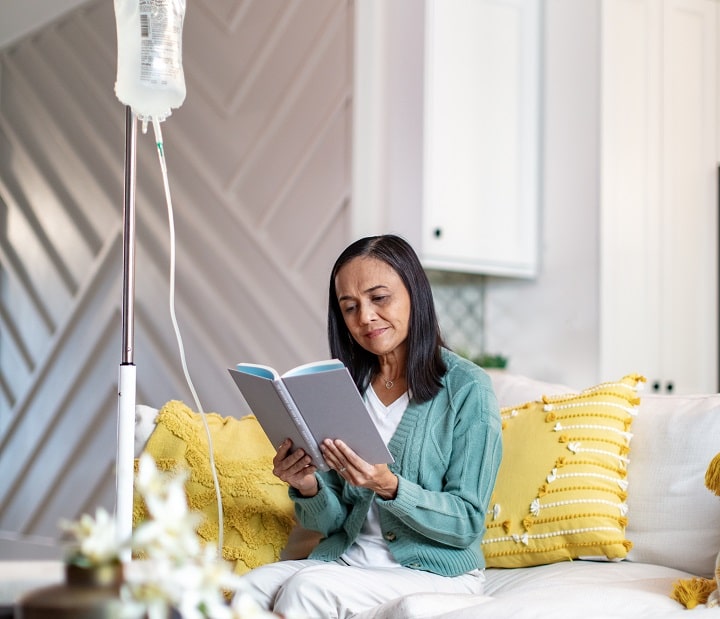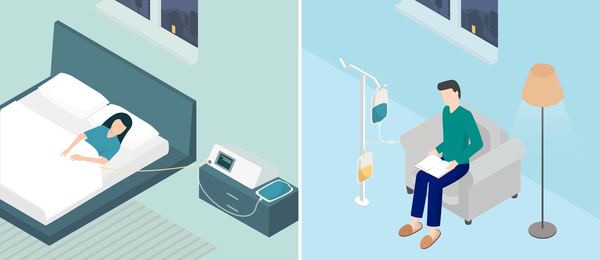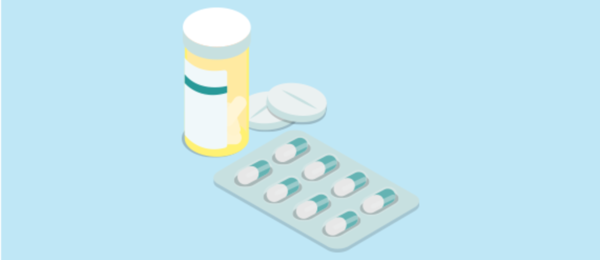Continuous ambulatory peritoneal dialysis (CAPD)
Continuous ambulatory peritoneal dialysis (CAPD) is a type of peritoneal dialysis (PD) that uses gravity to “exchange” your old dialysis solution for fresh solution.

What is CAPD?
Peritoneal dialysis uses the lining of your abdomen (also known as the peritoneum) as a natural filter to remove toxins from your blood.1
There are 2 types of PD: continuous ambulatory peritoneal dialysis (CAPD) and automated PD (APD).
CAPD is a form of PD therapy that is performed without a machine, using a manual process called an exchange. This process is usually performed 3 to 4 times per day, leaving solution in your abdomen overnight. Each exchange takes approximately 30 minutes. In between exchanges you are disconnected from the tubing and can continue with your usual activities until the next exchange.
CAPD can be carried out in any clean place. So, whether you’re at home, work, or even travelling, you can continue with your CAPD at your convenience.
How does CAPD work?
When you are having treatment with CAPD there is usually dialysis solution in your abdomen (from the previous session of CAPD). A catheter, which is a soft plastic tube, will have been inserted in your abdomen. You’ll attach a set of bags to your catheter: an empty bag (drain bag) and a bag containing clean dialysis solution. The drain bag is placed on the ground and the bag of clean fluid is place above up high so that gravity can help drain the fluid into your abdomen. This process of removing the used solution (known as effluent) and exchanging it with the fresh solution is known as an exchange (you have “exchanged” the old solution with fresh solution).
Once the fresh solution has entered your abdomen, the bags are disconnected, and a cap is placed on your catheter so you’re free to go about your day until your next exchange. Each exchange lasts about 30 minutes and happens between 1 and 4 times a day, depending on your dialysis requirements.
What are the benefits of CAPD?
Greater independence
CAPD equipment is more portable than other dialysis equipment, so you can perform dialysis even when travelling. You can carry out CAPD in different places like in the workplace or at home.3
Reduced physical stress
CAPD is known as a “continuous” therapy, which means that waste products and excess fluid can be controlled more easily during the treatment process, which is less taxing on the heart and blood vessels.2
A less restricted diet
A balanced diet is key for all chronic kidney disease (CKD) patients, but since CAPD is carried out several times a day, there is less time for waste to accumulate in your body compared to HD, which means that you can eat more of the foods you enjoy. Additionally, daily PD means that potassium removal is more efficient than HD, so PD patients don’t have to monitor their potassium intake as closely as HD patients.4
Longer lasting residual kidney function
Patients on PD may retain kidney function longer than people on HD.5
However, note that peritoneal dialysis might not be a good fit for all patients. When in doubt, speak to your clinician to find the right dialysis for your needs.

What is required for CAPD?
As with all forms of PD, you’ll require a few weeks of preparation. Before starting your treatment, a catheter will be inserted into your abdominal cavity near your navel for you to be able to perform your therapy. This minor surgery usually requires 14 days for wound healing before you start CAPD, to prevent any leakage.2 Sometimes, it can be used sooner if required to start earlier. Thereafter, your healthcare team will provide training on how you can perform CAPD safely and independently.
Some complications that may arise with PD include infection, weight gain and bloating.

What is it like to live with CAPD?
Like all dialysis treatments, you will need to accommodate some changes in your way of life. However, with a few minor adjustments, you’ll be able to continue living and working as usual. Here are some things to note:
- You'll need to adjust your daily schedule to accommodate the time you need to perform 3-4 CAPD exchanges a day
- Refrain from soaking in the bath or using a spa as this increases the risk of infection. However, you can still enjoy showers and ocean swimming.
Subscribe to My Kidney Journey Newsletter
Sign up now to receive exclusive content on kidney disease, treatment options, lifestyle tips and inspiring patient stories.
Where to go next?

Peritoneal dialysis (PD) at home
APD is a type of peritoneal dialysis, which is different from haemodialysis. We explain more on PD.

In-centre haemodialysis (In-Centre HD)
You may prefer to receive dialysis at a hospital or treatment centre near you with ICHD.

Conservative care
If you and your clinician decide dialysis isn’t right for you, there are other treatment options you may consider.
